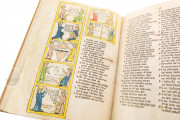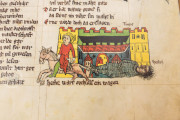The Der Wälsche Gast is an interesting moral treaty written by Thomasin von Zirclaere and it is the only work of his to reach modern times. Although an Italian native, the lyric poet chooses to use Middle High German to talk about topics concerning courtly love and chivalry, mainly aiming at lecturing young adults.
A German-Italian Artist
Although the poet was born in Friuli c.1186-1235, this manuscript was created a little over a century later, in 1340, leading us to believe that the work was very popular and of interest.
Most of the information regarding Thomasin von Zirclaere, also known as Tommasino Di Cerclaria, is gathered from the text itself, which is also considered to be an extremely important source for linguistic researchers due to the use of German by a non-native speaker.
Moral Discussion
This work – considered the oldest comprehensive behavioral theory in German language – is divided in ten books. In the following books, the author speaks to knights, ladies, and clerics reminding them to be a role model for the rest of society. Values such as generosity and moderation are considered extremely important and are discussed throughout.
A great part of the work revolves around the instability of human nature, with every man seeking only his well-being.
The illustrations – acting as an aid to the reader – result quite bizarre, an example being f.25r which depicts a dog pulling the cart while an ox runs after a hare – certainly a paradox. This image symbolizes how it is useless to want to reverse the order of things which was given by God, for men should accept their fate.
A Popular Work
The manuscript, now safely stored in Gotha, features 120 illustrations which act as a visual aid to the reader helping him to understand the concepts and the topics discussed. Throughout the centuries several copies were made – 13 manuscripts reached modern times, the oldest dating back to the 13th century (cod. Pal. Germ. 389) – but Ms. Memb I 120, so far, appears to be the most complete copy of the work of the Italian poet.
Across the 13 manuscripts there is a striking resemblance in terms of iconographic apparatus (from the texts’ selection to the disposition of figures and objects), which has led some scholars to believe that the illustrative schemes might originate from a single manuscript, possibly dating back to the first half of the 13th century.
We have 1 facsimile edition of the manuscript "Der Wälsche Gast": Der Welsche Gast facsimile edition, published by Quaternio Verlag Luzern, 2018
Request Info / Price

































